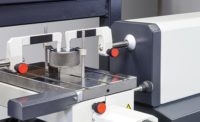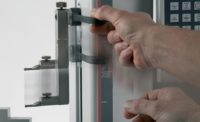Traditionally the length of a production run was a key factor in the selection of a dimensional gaging system. Typically, the higher the production run, the more cost effective a dedicated or customized gaging system was likely to be, while shorter runs would require greater flexibility and versatility in gaging. A dedicated gage would be faster, more accurate, and least subject to operator influence, but would also likely be more expensive. However, because that cost could be amortized over the long production run, it would ultimately provide the most cost-effective solution. A more general gaging system, on the other hand, would be less expensive and able to measure a greater variety of parts and dimensions, but could require more complex setups, more operator skill, and have longer measuring cycles.
These days that logic may be changing. For one thing, the days of long runs of the same parts are pretty much over. In today’s manufacturing environment, short runs and quick changeovers are becoming the rule, and both speed and flexibility in gaging systems has become key. At the same time, the long-term trend toward tighter tolerances requires systems with greater inherent accuracy as well.
Thus, new modular-based systems are now coming on the market that can provide the best of both traditional worlds: systems with components that provide the flexibility and versatility of a general gage, yet which can also combine to provide the speed and accuracy of a dedicated solution, and all with a value quotient that exceeds both extremes.
Such systems are not expected to replace traditional gages, but to add another dimension to the gaging paradigm. In this article we’ll look at some of the concepts behind these new systems and how they will augment existing options.
Traditional Gaging Options
In the traditional paradigm described above, there were basically three categories of gaging systems (not counting such things as CMMs, optical comparators and the like) for measuring ODs, IDs and lengths. These were calipers and micrometers; comparative gages; and high-end, custom or dedicated comparative gaging systems. The choice depended on many factors including throughput, ease of use, accuracy, cost, and the measuring capabilities of various gage features.
Calipers and Micrometers
At the low-precision, high-flexibility end of the spectrum are handheld gages such as calipers and micrometers. Both are extremely versatile and useful tools for making a wide range of distance measurements (both ODs and IDs). Of the two, the micrometer is more popular and offers a small step up in accuracy and performance—but with a shorter measuring range. However, both require time and operator skill for positioning the tool and interpreting the measurement result. So while they can measure a wide range of different parts, both are at the mercy of the operator, and measuring system accuracy leaves much to be desired.
Comparative Gages
Once tolerances reach the 0.0005 inch level, you begin to enter the region where comparative gages such as bench stands, snap gages, or ID/OD gages are required.
For example, say you have operators checking a shaft diameter on a CNC lathe after the manufacturing process is complete. Micrometers might be suitable, and maybe you could resolve to 0.00005 inch or so. But let’s say you need to check the diameter at multiple locations to ensure there is no taper in the part. Just picture the operator bringing the micrometer over, getting it to nearly the right size, adjusting the torque to the correct gaging pressure, removing the micrometer to read the size, then moving on to the next location: this process wastes time and money, not to mention incorporating the influence of the operator. A better choice would be an adjustable snap gage.
Snap gages can be handheld to measure workpiece ODs while still on the machine, or can be mounted on stands for use with small parts. The heart of the tool is a simple C-frame casting, and measurements rely upon a direct in-line 1:1 transfer of motion. These factors make snap gages simple, reliable, and fairly inexpensive.
In addition to higher performance, measurement with a snap gage is fast and nearly impervious to operator influence. There is no need to adjust the gage to the right size, or to assure the gage is square to the part, or to apply the right force on the part. It’s all built into the gage. Thus, snap gages improve performance through speed and accuracy.
Custom Fixtures
Now take that same shaft and give it multiple diameters. While snap gages are adjustable to size, they can only measure a very limited range. In order to retain speed and accuracy, multiple snap gages could be needed to check the part. However, every diameter would require a different gage and additional time to make the check. With six diameters to check, you would need six gages and six separate measuring operations.
Custom fixture gaging may be the best solution for these measurements. A custom fixture gage offers the best in performance and throughput. But because they are custom designed and produced, they are often expensive and not flexible enough to accommodate part variations going though flexible machining centers. Thus, investment can be large if a custom gage is required for each part being produced. This is where a modular multi-gage system can fit.
The Modular Multi-Gage Concept
The idea of the multi-gage is to take all the elements found in high precision comparative gaging and turn them into modular components. When one looks at the parts of a comparative gage there are very basic components common to all of them. For example, good comparative gages all have good solid reference anvils or contacts, a sensitive contact, part references (backstops), and a readout, all tied together with a robust frame for stability.
The use of these standard components allows multi-gage measuring devices to be designed and assembled for the widest possible range of workpieces. And since they are constructed of all common elements, they can easily be re-configured for similar or different applications. So where a traditional comparative gage may have been built for one size shaft with five diameters, a new multi-gage can easily be adjusted for five different shafts having different diameters at different locations.
Flexible gaging would require an instrumentation package—perhaps tablet based—that would store all the various programs for the parts to be measured. Thus, changeover would simply involve reconfiguring the gage to the new part and selecting the correct part program. This ties in perfectly with the same concept in manufacturing: use the same machine to produce similar parts with fast and easy changeovers via a new set of pre-set tooling and a new part program.
Thus, while the machine operator changes tooling and reprograms the machine for the new part, the gage technician resets the modular gaging elements to the new part and selects the correct gaging program.
Whether measuring an outside diameter, inside diameter or length measurement, the modular multi-gage elements can be configured for the simplest parts or even the most complex workpiece geometries. And because the modular components are all designed to be as small as possible, a high number of measuring points can be inspected within a small area of the workpiece.
Just as there are different levels of performance and robustness in the design of standard handheld comparative gaging, modular multi-gage components employ a similar design philosophy. Should the tolerance on the part be fairly “wide open” there is a modular element that can accomplish the task with the proper level of precision and value. However, should the manufacturing process be in a relatively harsh environment with tight tolerances, there are elements and gaging techniques available to meet these needs as well.
Multi-Gage Configurations
Let’s take a look at the components for a “good, better, best” approach to measuring an outside diameter.
Good
The most cost efficient is to use a single LVDT (or digital indicator) and a set of parallelograms linked together as shown in Figure 1. This is the “most value” version for a simple dimensional check and offers fairly good performance. Because the parallelograms are virtually friction free they can provide years of service. And since there is only one transducer involved, the cost may be the lowest.
Better
Another fairly economical approach, shown in Figure 2, would be to use a single LVDT and measure the part “differentially” by mechanically linking the two parallelograms. With proper contact positioning and good long lead-ins on the contacts, the part can slide easily into the gaging station. Better yet, take all of the potential abuse off of the probe and parallelogram frame by using versions with pneumatic retraction.
Best
The best in terms of accuracy and long-term performance is to use a precision ball bushing mechanism with pneumatic retraction like the one shown in Figure 3. This protects the LVDTs from shock, as they only touch the part when the probes are released into position, and the ball bushing construction provides extremely long life.
A variation of this, when there is enough real estate on the part and the tolerances are tight, is to use precision LVDTs that employ the same style precision ball bushing and pneumatic retraction, thus placing the probe directly in contact with the part. The pneumatic retraction prevents side loading of the probe and may offer the best performance overall.
Concept Economies
Besides the robustness of the various configurations, another benefit of the flexible, multi-gage system is the economies inherent in the concept. These include:
- Reusability of standard elements: once manufacture of a particular type of workpiece has ceased, all standard elements used in the test equipment can be reused for a different type of workpiece.
- A choice of different mechanisms for guiding the moving part of the stylus, according to the accuracy requirements of the measuring task.
- Reduction in development and implementation time.
- Availability of the equipment: standard elements can be stocked by the supplier for immediate delivery when new gaging requirements emerge.
All the systems can be constructed by the customer from standard elements obtained from a catalog. But if needed, these elements can be assembled as a complete solution for the first setup and then changed later by the end user.
It should also be noted that the gaging systems or the readouts need be just as flexible as the gaging elements. Dial indicators are the most economical and flexible (when accuracy and space limitations permit). But when the performance of electronic gaging is required, look for systems that offer the same modularity in selecting input, and computation options that provide the same flexibility. Look for capabilities of creating multiple inputs from different sensors (LVDTs, digital probes, analog or air). Gaging computers offer gaging software for multiple part programs, part classification, and data storage and analysis. Thus just as easily as the hardware can be configured for easy changeover to a new part, the gaging control package should match this flexibility.
Modular multi-gage systems are very new and still under active development. As noted above, these systems are not intended to replace either lower precision handheld gages such as calipers and micrometers, or higher precision tools such as snap gages, bench stands or more traditional ID/OD gages. Instead, these systems are intended to interleave with existing gages to help adapt inspection methodologies to an ever evolving manufacturing environment.
TECH TIPS
|








